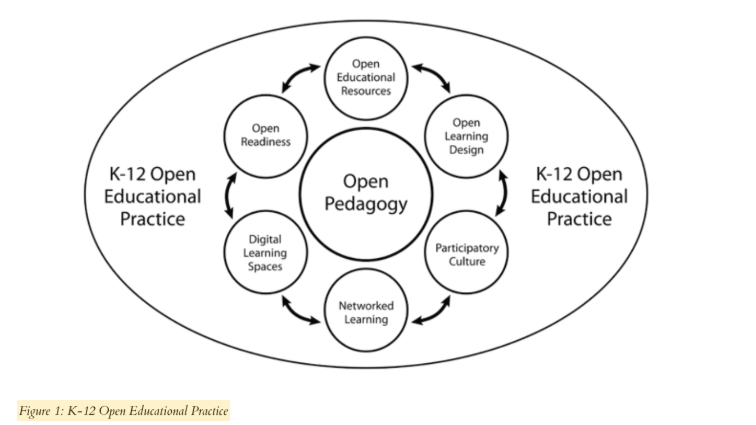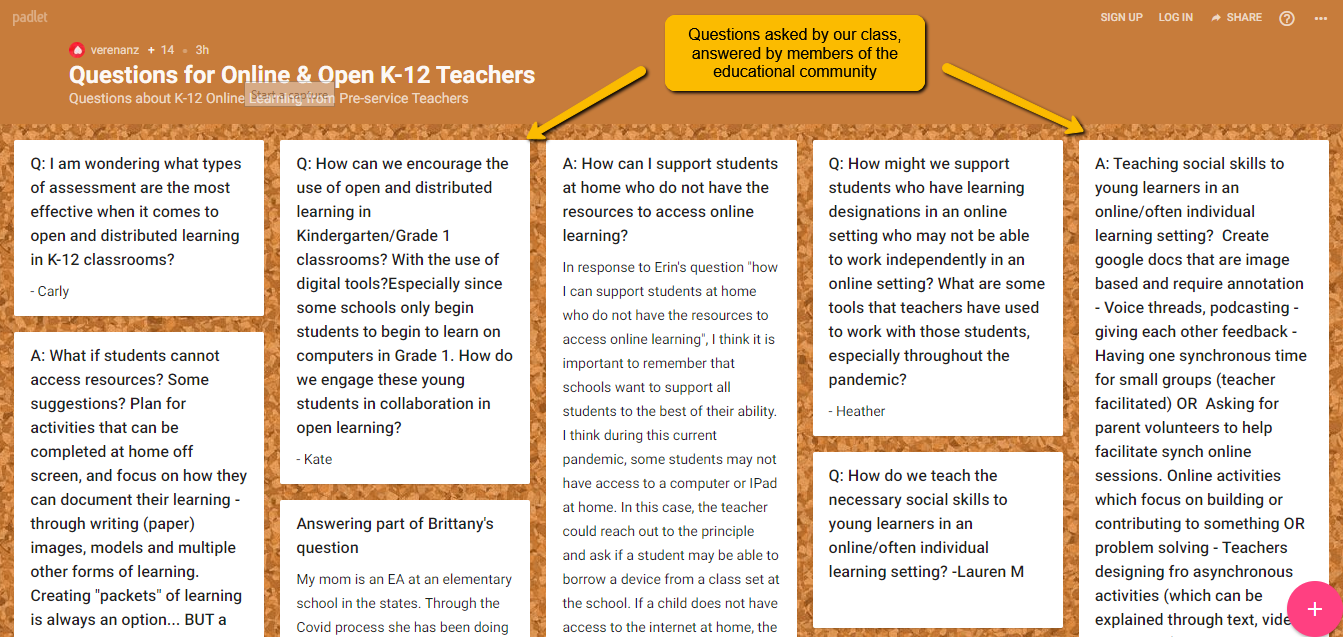Before diving into this week’s readings and activities, I was unfamiliar with the history, theories, and overall distinctions between varying types of distributed and open learning approaches in Canada. I found it really interesting to learn about how open and distributed learning has developed, changed and continued to evolve over time in its practices throughout differing contexts.
Learning Theories – A Quick Summary
- Behaviorism: believes in reward and punishment as a means of reinforcing a specific behavior response through the association with particular stimuli or events. This approach attempts to maintain a high degree of objectivity in viewing human activity and seeks to measure learning through pre-defined and measurable outcomes.
- Cognitivism: focuses on the psychological mental processes – internal and conscious representations of the world – that affect learning, thinking and behavior (e.g conscious thought, decision making, emotions, expressing ideas).
- Constructivism: believes that people actively strive for and create meaning of their environments by considering past experience and their present state through “personal reflection, seeking new information, to testing ideas through social contact with others” (Bates, 2018).
- Connectivism: founded on the principles of learner autonomy, openness (access to course content, activities, assessment), diversity (in content, perspectives, tools) and interactivity. Best suited for informal learning or communities of practice.
One main idea I took away from Bates’ post was the importance of developing an understanding of varying theoretical approaches (including alternative ones) as they can be useful in many different situations and contexts, such as online, face to face or blended environments. Doing so puts you in a better position to make choices regarding your approach in teaching and meeting the needs of your learners.
Learning Spaces – Open & Distributed Learning
Reading through and annotating this week’s articles with my pod group has given me a better understanding of open education practices and what types of learning and teaching falls under this general ‘umbrella’ term.
Open Education Practices describes a type of pedagogy (teaching and learning method) rather than a specific learning theory. As defined by the International Council for Open and Distance Education, OEP are practices which “…support the productions, and reuse of high quality open educational resources (OER) through institutional policies, which promote innovative pedagogical models, and respect and empower learners as co-producers on their lifelong learning path” (Roberts et al., 2018, p. 528). It is supported by the findings and understandings of prominent theorists such as Dewey (1916), Vygotsky (1978), Pacquette (2005).

Through teacher facilitation of OEP, students “identify and locate learning opportunities for themselves as well as create learning opportunities for others” (Roberts et al., 2018, p. 530) whilst working on an equity basis with the premise of access to choice, time, place, medium and content through a participatory culture.
Open learning involves intentional design that expands learning opportunities for all learners beyond class walls. Examples from course activities this week include engaging with the Twitter hashtag and Padlet Q&A.

Distributed learning – includes online, blended and e-learning (in a BC context). This medium opens up opportunity by allowing flexibility outside of regular classroom schedules and providing greater student access and choice.
- Blended Learning involves a mix of online learning and traditional brick and mortar setting. It leverages the internet to “afford each student a more personalized learning experience, including increased student control over the time, place, path, and/or pace of learning” (Christensen Institute, n.d.)
- Online E-Learning is “the implementation of computer technologies to education. [It] can take many forms, whether it is used face-to-face in classrooms, as a share of required classroom activities or stroke work (e.g., online discussions), or to deliver a fully online course. E-learning can include distance education as well as traditional in-class instruction” (Barbour et al., 2018, p. 602)
Context and History
Distance and distributed learning in Canada, which began over 100 years ago in 1919, started out as a way to improve student access to information, material and resources. As a country with a vast geography and limited and dispersed population, it becomes clear why Canada has a deep history in and is a leader of incorporating this type of learning into the K-12 education system. Since new technology has emerged, other models and programs of learning have become possible – in 1993, virtual schools were in introduced in BC; in 1994, Ontario, Alberta, Manitoba and Newfoundland & Labrador launched district based online learning; and in 2008, the Canadian Learning Network (CANeLearn) was created to service distance and online learning across the country (Barbour, et al., 2018).

From the recorded webinar with Dr. Barbour, Dr. LaBonte and Dr. Roberts, a key aspect of effectively implementing distributed and open learning models that was discussed was the importance of intention – in designing and structuring your learning space. How you want to deliver content, facilitate social interactions, and connect with your students should be guided by your overall pedagogy, which may be supported by your choice in digital technology. Ultimately, the technology you decide to use shouldn’t be the factor driving learning – it should be lead by you and your pedagogy.
References
Barbour, M & Labonte, R. (2018). An Overview of eLearning Organizations and Practices in Canada. In R. Ferdig & K. Kennedy (Eds.), Handbook of research on K-12 online and blended learning (pp. 600-616). Pittsburgh, PA: Carnegie Mellon University ETC Press.
Bates, T. (2014). Learning Theories and Online Learning. [Blog post]. Retrieved from https://www.tonybates.ca/2014/07/29/learning-theories-and-online-learning/.
Christensen Institute. (n.d.). Blended learning. https://bit.ly/2Zr9lH8
Roberts, V., Blomgren, C., Ishmael, K., & Graham, L. (2018). Open Educational Practices on K-12 Online and Blended Learning Environments. In R. Ferdig & K. Kennedy (Eds.), Handbook of research on K-12 online and blended learning (pp. 600-616). Pittsburgh, PA: Carnegie Mellon University ETC Press.






Verena Roberts
July 15, 2020 — 7:52 am
Really well done Leona! This is an outstanding summary of the key “themes” for Topic 2. It helps me by giving me feedback on what may have supported your learning as well (You mentioned the annotation activity, twitter, the padlet and the webinar recording for example…). Keep up the great work!
Dr. R:)
tmalm
July 15, 2020 — 5:59 pm
Another great post Leona!
Every time that I read something of yours I feel like I’m reading an English professor’s writing. Again, I love how you structured your blog entry and it will influence both how I format my work and how I write in the future. Additionally, reading this actually gave me a better understanding of this week’s reading due to the concise nature of your work. I appreciate that you mentioned our group annotating because I enjoyed it and I’m sure Josh and Kirby did as well. I hope that all the positive feedback that you receive and the knowledge and experiences that you are gaining give you the confidence to share your gifts of intelligence with the world.
kirbyjarvis
July 15, 2020 — 6:52 pm
Hey Leona!
From reading your blog, I feel as if I have re-learned this topic in a summarized form (which I guess is the point)! I love how you gave definitions of each of the learning theories and, now I am thinking for my next blog I may do the same! I really wish I could have experienced the live webinar with Dr. Barbour, Dr. LaBonte, and Dr. Roberts because I can only imagine how meaningful it was to this topic. However, I can’t agree more with your statement about “intention.” I feel that in the day and age where technology is seeming to take over our lives and teachers are getting frustrated too often thinking they are losing control over how they teach. I saw this happen to my dad when one of his favourite classroom year-end project had to be canceled because to him “it wasn’t possible with the technology they had access with” however like you said, “Ultimately, the technology you decide to use shouldn’t be the factor driving learning – it should be lead by you and your pedagogy.” (You)